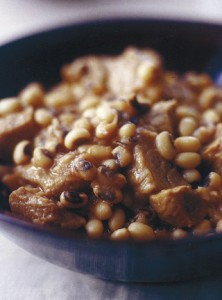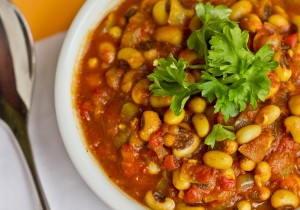“May it be Your Will That Our Merits Increase Like The Black-Eyed Peas.”
1/2 pound dried black-eyed peas, or 3-4 cups frozen black-eyed peas cooked according to directions on package
5 cups water 1 tablespoon tomato paste
3/4 teaspoon ground coriander
1/2 teaspoon ground cumin
1/2 teaspoon paprika salt and pepper and cayenne pepper
1 tablespoon olive oil
1 large chopped onion
2 tablespoons chopped cilantro
To prepare the peas: pick them over, getting rid of any pebbles and broken or discolored peas. Soak them 8 hours or overnight in water to cover; or put them in a saucepan with a quart of water, bring to boil, boil uncovered 2 minutes, remove from heat, cover and let stand one hour. Drain and rinse the peas. Put them into a medium saucepan and add the water. Bring to a simmer, cover, and cook about 1 1/2 hours (or until tender) over low heat. Drain the peas, reserving 1/4 cup cooking liquid. (I’d reserve more to be on the safe side; this doesn’t seem like enough to me.) Put drained peas into a medium saucepan. Mix the reserved cooking liquid with the tomato paste and add it to the pot. Add the coriander, cumin, paprika, salt, pepper and cayenne pepper. Bring to a simmer and remove from heat. In a heavy skillet, heat the olive oil, add the onion, and saute over medium head, stirring often, about five minutes. (She uses a non-stick skillet; you might need more oil with a regular skillet.) When the onion begins to brown, add a tablespoon of water and saute until the onion is deeply browned. Then add the onion to the pea pot, cover, and gently heat for five minutes. Add half the cilantro. Taste and adjust seasoning. Serve it sprinkled with the other half the cilantro. Beth Greenfeld.
Rosh Hashanah Egyptian Black-Eyed Peas by Diane Kaufman-Tobin
Ingredients:
1 onion, chopped
3 tablespoons sunflower oil
2 garlic cloves, minced or crushed in a press
1.5 lb (750g) lamb or veal, cubed (optional)
1 lb (500g) tomatoes, peeled and chopped
3 tablespoons tomato paste
1 lb (500g) dried black-eyed peas, soaked for 1 hour
1 teaspoon cinnamon
1/2 teaspoon allspice
Salt and pepper
1-2 teaspoons sugar
Directions:
Fry the onion in the oil till golden. Add the garlic, and when aroma rises add the meat. Stir to brown it all over. Add the tomatoes and tomato paste. Drain the black-eyed peas, and simmer on fresh water for 15 minutes, then drain and add them to the meat. Add cinnamon and allspice and cook for 2 hours, adding salt and pepper to taste and the sugar after about 1 hour.

Quentin Bacon, Photographer:
New Year’s Table: A tradition for Syrian Jews and those from the American South. Recipes: ‘Aromas of Aleppo’
At Rosh Hashanah, Black-eyed Peas for Good Fortune
A Google search linking black-eyed peas and Jews reveals a wide discussion about the Jewish roots of the popular hip-hop band (sadly, none) and a riff on Lenny Bruce’s Jewish vs. goyish shtick that peas are Jewish while black-eyed ones are goyish.
But black-eyed peas are Jewish. Jews from both Syria and the American South eat them as part of a celebratory meal on Rosh Hashanah.
One tradition dates back to a 2,500-year-old text and the other crops up in the mid 20th century. Could the two be connected?
The peas — actually beans from the cowpea family — are white with a small black circle, or “eye,” near the base. Indigenous to West Africa, Ethiopia or the Far East (depending on your source), they made their way to Judea at least 500 years before the Common Era and were brought to America by slaves in the 17th century. When cooked alone they are relatively bland; however, being easy to grow and high in protein and carbohydrates makes them an inexpensive staple in Southern states and in the Middle East, though not much of a holiday treat.
Poopa Dweck, author of “Aromas of Aleppo” (HarperCollins, 2007), explains in her book that Syrian Jewish families begin the New Year with a Seder, a ceremony before a Rosh Hashanah meal. “The foods of the New Year holiday symbolize a wish for a sweet year. Aleppian Jews eat several symbolic foods during the Rosh Hashanah dinner… that correspond to the wishes of the Jewish people for the coming year,” she writes.
The tradition comes from the Babylonian Talmud, which states, “Abaye said, ‘Now that you have said that an omen is significant, at the beginning of each year, each person should accustom himself to eat gourds, black-eyed peas, fenugreek….” Each of the foods (nine in total) represents something different for the year ahead; the black-eyed peas symbolize good fortune. For a Syrian meal, they’re traditionally prepared in a simple recipe with garlic, onions and veal. The dish can be spiced up with cinnamon and allspice or flavored with tomatoes or tomato paste.
The dish symbolizes prosperity in ways: A single serving contains so many of the small beans and the dish’s name pays homage to abundance. Black-eyed peas are rubiyah (in Aramaic and Hebrew) or lubiya (in Arabic), which are cognates of the Hebrew words harbeh, meaning many, and l’harabot, to increase. The idea is to take in prosperity at the start of the year, with the hope that it will serve as a good omen for the year ahead. While the Syrian Jewish community is the only one to eat the beans in a Seder Rosh Hashanah, other Sephardic communities have adopted the tradition of the Rosh Hashanah beans.
This culinary tradition likely arrived in America with Sephardic Jews who moved to the South in the 18th century. Many Jews of the South had black cooks, who prepared a combination of what their Jewish owners or bosses requested and dishes from their own culinary traditions. In the case of black-eyed peas, those traditions overlapped, both groups having their own preparations of the beans. Though the two black-eyed pea traditions intersected in the early South, they didn’t meld into one; nor did one seem to rub off on the other.
Around the same time, the tradition of eating black-eyed peas January 1, still widely popular in the American South, was crystallizing in the surrounding non-Jewish communities. Hoppin’ John, a dish made with black-eyed peas, rice and pork, is eaten to obtain a prosperous year. It’s served in a meal alongside greens whose leaves symbolize paper money, thus wealth.
The sources of both the dish’s name and its symbolism have become the province of legend and lore. Some argue that the beans represent coins, while others argue that because they expand while cooking, they represent abundance. Southern food historian John Taylor explains that the combination of rice and beans in the dish came “with the enslaved” from Africa, while the tradition of eating them on “New Year’s probably came from the Caribbean, where they prepare a similar dish called Moros y Cristianos (Moors and Christians).”
The first recipe on record for the dish in the South is in “The Carolina Housewife,” from 1847, one of the nation’s earliest cookbooks. It’s likely, however, that the dish was prepared much earlier, particularly since its roots are in slave culinary traditions, which were maintained orally. Over time, the dish was adopted by white Southerners for whom the slaves cooked, and was incorporated into the greater Southern culinary canon, particularly of the low country in the Carolinas and parts of Virginia and Georgia.
More than 150 years later, the dish not only appears in households on secular New Year’s Day, but also in kosher variations on tables of Jewish families in the South celebrating the Jewish New Year. Jewish recipes (found in Sisterhood cookbooks from the South) often replace the pork with a smoked turkey leg, but there are also vegetarian preparations.
Marcie Cohen Ferris, author of “Matzoh Ball Gumbo” (University of North Carolina Press, 2005), explains that the tradition started in the 1960s: “On holidays, people cook traditionally, but there’s a group of people who like to add in regional flavors to give it a signature of place. What could be more of a symbolic dish than to grab that dish from the secular New Year’s and claim it for Rosh Hashanah?”
Ironically, it is by adopting this African-Caribbean-Southern-Christian tradition (possibly inflected by local Sephardim) that the Jews of the South are reclaiming and reconnecting to a Jewish tradition that dates back more than 2,000 years. by DevraFerst, The Jewish Daily Forward
L’shanah Tovah Tikatev V’taihatem!
May you be inscribed and sealed for a good year!
 Artist: Lynn Feldman ~ Serigraph: She Blew the Shofar
Artist: Lynn Feldman ~ Serigraph: She Blew the Shofar


